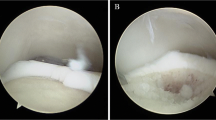Abstract
Objective. T2-weighted MR images has been reported to be an accurate method for assessing osteochondritis dissecans. We reviewed our MR experience to confirm the accuracy of the published criteria of instability. We also assessed the value of each of four MR signs of instability. Design. We reviewed the original MR interpretations, arthroscopic reports, and MR examinations of 40 patients with osteochondritis dissecans of the talar dome or femoral condyles. Arthroscopy was used as the gold standard for stability. The MR examinations were reviewed retrospectively for a high-signal-intensity line or cystic area beneath the lesion, a high-signal-intensity line through the articular cartilage, or a focal articular defect. Patients. All patients who had undergone MR imaging for osteochondritis dissecans from 1990 to 1993 were reviewed. Forty patients were identified who had arthroscopy after the MR examination. There were 30 male and 10 female patients with an average age of 25.7 years. Thirty-one lesions were in a femoral condyle and nine were in the talar dome. Results and conclusions. The original MR interpretations correctly identified 35 of the 36 unstable lesions and all 4 stable lesions, giving a sensitivity of 0.97 and specificity of 1.0. There was a 98% agreement between the original and retrospective diagnoses. A high-signal-intensity line was seen beneath 72% of the 36 unstable lesions. The other three signs were noted in 22–31% of the unstable lesions. Fifty-six percent of the unstable lesions showed only one sign of instability. MR imaging is a highly sensitive method for detection of unstable osteochondritis dissecans. The presence of any one sign indicates instability, the most frequent sign being an underlying high-signal-intensity line. Because we examined only four stable lesions, our 95% confidence interval of 0.40–1.0 for a specificity of 1.0 gives only a limited estimate of the specificity of MR.
Similar content being viewed by others
Author information
Authors and Affiliations
Rights and permissions
About this article
Cite this article
Smet, A., Ilahi, O. & Graf, B. Reassessment of the MR criteria for stability of osteochondritis dissecans in the knee and ankle. Skeletal Radiol 25, 159–163 (1996). https://doi.org/10.1007/s002560050054
Issue Date:
DOI: https://doi.org/10.1007/s002560050054




